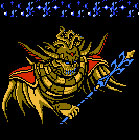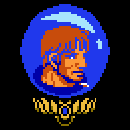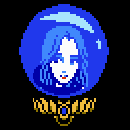Spotlight: Final Fantasy II
 Video games were in a state of transition in 1991. The glory days of 8-bit gaming, largely led
by the Nintendo Entertainment System, were fading due to Sega's new 16-bit console, the Genesis.
Developers now had to look ahead at creating new games for the next generation of game systems,
and the once-mighty NES was quickly looking less-than-profitable.
Video games were in a state of transition in 1991. The glory days of 8-bit gaming, largely led
by the Nintendo Entertainment System, were fading due to Sega's new 16-bit console, the Genesis.
Developers now had to look ahead at creating new games for the next generation of game systems,
and the once-mighty NES was quickly looking less-than-profitable.
Squaresoft had enjoyed moderate success in the North American market with the 1990 release of Final Fantasy for the NES. Two sequels were already out on the Nintendo Famicom in Japan, and a new installment was in production for Nintendo's upcoming 16-bit successor.
The success of the Final Fantasy series in Japan gave Square several options for their follow-up release in the North American market. Ultimately, they repackaged the Japanese release of Final Fantasy IV for the Super Famicom and renamed it Final Fantasy II to hide any continuity issues.*
But early in 1991, that decision was far from final. At one point in time, Square explored the possibility of bringing the original Famicom version of Final Fantasy II to the NES. The following story examines this abandoned game.
- By Chris Collette
"The idea was to continue with subsequent Final Fantasy products," Ted Woolsey recalls. "Unfortunately, for a variety of reasons ... these were never launched, though that doesn't mean there weren't localizations afoot for one or more of them."
Woolsey, who worked for Squaresoft as a translator during the early and mid 1990s, does not remember specifically testing Final Fantasy II for the NES. His first project for Square had been to examine the translated script for the Super Nintendo release of Final Fantasy IV. By that time, Final Fantasy II for the NES had already been scrapped.
Games such as Final Fantasy II were "pretty amazing games for their time," Woolsey notes. "Too bad they never saw the light of day outside of Japan!"
 Final Fantasy II is perhaps one of the most peculiar titles in the series. Graphically
similar to the original Final Fantasy, this installment follows the quest of four young
adventurers who take up a rebellion against an oppressive empire. The depth of the storyline far
exceeds its predecessor, with a much more complicated plot as well as a larger cast of heroes and villains.
Final Fantasy II is perhaps one of the most peculiar titles in the series. Graphically
similar to the original Final Fantasy, this installment follows the quest of four young
adventurers who take up a rebellion against an oppressive empire. The depth of the storyline far
exceeds its predecessor, with a much more complicated plot as well as a larger cast of heroes and villains.
The game also has an unusual system of leveling up your party members. Character traits are improved depending upon what actions they perform in battle and not by gaining experience points for defeating enemies, which is the common method used in most role playing games.
If a character uses physical attacks during a battle, both his strength and his proficiency with the weapon that was used can increase; however, the statistics pertaining to his magical ability may decrease. This unique method of character building introduces an element of strategical checks and balances to the game, and it can be quite challenging to master.
It's interesting to note that this innovative system was abandoned after Final Fantasy II and never used again in the Final Fantasy series.
The radically different battle system, along with the advent of the Super NES are probably major factors that kept this game from being released in America. However, a script was indeed translated into English in early 1991, and a working prototype of the game was created. The translator was Kaoru Moriyama.
"Thinking back, it was a tough job translating at that time," says Moriyama, who worked as a translator for several Squaresoft games in the early 1990s, including Final Fantasy IV and Secret of Mana. "We had so very limited memory capacity we could use for each game, and it was never really 'translating' but chopping up the information and cramming them back in."
And although unintentional, that is perhaps Final Fantasy II's defining characteristic. The English script is clunky and erroneous to the point that players may find the dialogue between characters quite comical. It can be very hard not to snicker when a character declares, "We are all in here because of that old man's Xtal Rod!!"
Moriyama is quick to point out her script is very preliminary. Additionally, the script was cut down in length "to fit the text area for compilation."
The result is a guilty pleasure. The game was neither ready nor intended for release at this stage of completion. The project was cancelled shortly after this point, and thus the translation was never refined.
The game was completed to the point that it can be played from start to finish. It is just that the dialogue remains in a constant state of mangled English throughout.
 Even if the game had eventually been released, a complete translation may still have suffered from limitations
in the game's coding itself. For example, Final Fantasy IV on the Super NES also suffered from
translation problems in the script when it came out in 1991; many fans of the game often identify the line "You
spoony bard!" as one of the greatest ever in a video game.
Even if the game had eventually been released, a complete translation may still have suffered from limitations
in the game's coding itself. For example, Final Fantasy IV on the Super NES also suffered from
translation problems in the script when it came out in 1991; many fans of the game often identify the line "You
spoony bard!" as one of the greatest ever in a video game.
"Usually, the 'beautifully translated' version of the text had six to eight times more letters than we can afford for screen text," Moriyama explains. "So the toughest job was to chop them off and squeeze them back into the allocated area."
Another thing to consider is that in the early 1990's, many Japanese videogame companies, Square included, didn't feel the need to put much effort into any English translations.
"Our boss [Hironobu Sakaguchi] had no understanding in putting in extra work for the English version at that time," says Moriyama. "Besides," she adds, "we usually had too much text already in Japanese to fit in whatever the ROM size was."
Sakaguchi eventually wised up to the importance of a good English translation, although human resources to do so remained thin long after Final Fantasy II's cancellation. Ted Woolsey recalls Sakaguchi talking to him at length about improving the quality of games.
"I didn't have a team to do this work, but had to keep all the disparate files and content in my head, remembering snippets of conversation from one file to add to messages from another file," says Woolsey. "It was easy to make a boo boo, especially under the time crunch. I just had to do my best, and fortunately, I had some fun doing these."
 Final Fantasy II ultimately saw official release in America when Square remade it as one of two games to
appear on the Final Fantasy Origins compilation for the Sony Playstation in 2002. This release was a
complete remake of the game, featuring updated graphics and an entirely different translation than the one used
in the NES prototype.
Final Fantasy II ultimately saw official release in America when Square remade it as one of two games to
appear on the Final Fantasy Origins compilation for the Sony Playstation in 2002. This release was a
complete remake of the game, featuring updated graphics and an entirely different translation than the one used
in the NES prototype.
While Final Fantasy II is no longer a truly "unreleased" game for English-speaking audiences, this original translation serves as an intriguing footnote to the game's history. The game should be recognized for what it is rather than judged by the amusing dialogue contained within. It is an early attempt at localizing an incredibly complex game.
"It is not at all close to completion," Kaoru Moriyama notes. "It just 'works.'"
* To maintain consistency and minimize confusion, for this article I've changed all future references of Final Fantasy II for SNES to Final Fantasy IV instead. The other sequel released on the Famicom, Final Fantasy III, remains officially unreleased in any form in North America at the time of this writing.
Special thanks to Kaoru Moriyama, Ted Woolsey, and Pat Lacy for their generous help in the making of this article.